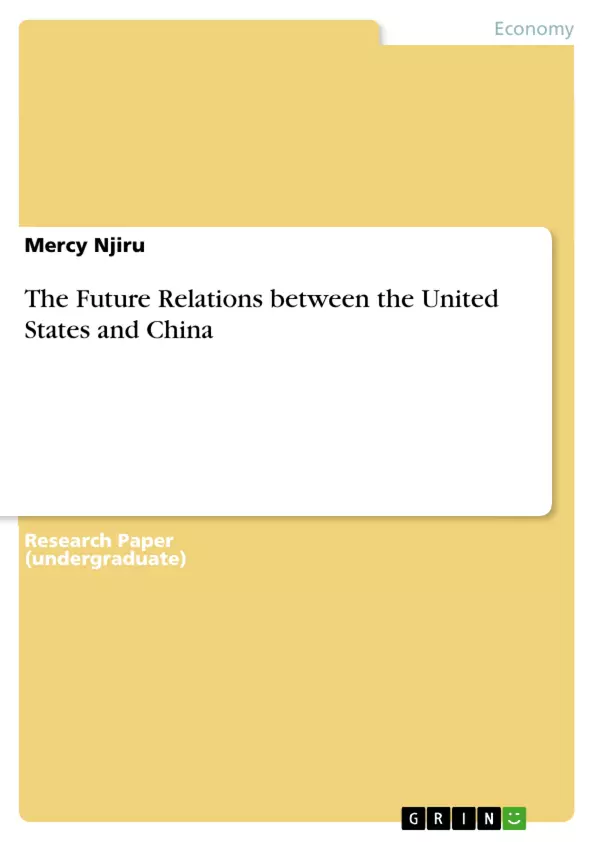Between 1941 and 1991, the key significance of China to the U.S. had been one among the most lasting legends of Sino-American relationship. However, actually, China had had just a secondary significance, and its importance was in the context of crises with other nations, which had partially influenced the U.S diplomacy towards China during the 50 years.
Accordingly, the cessation of the Cold War era needed the US foreign policy to reassess the significance of China. It has since become evident that future lasting stability in the Asia-Pacific area substantially rests on harmonious relationship among the U.S, Japan, and China. To the point that the three nations can join forces, they will establish a generally nonthreatening security atmosphere and manage the disputes sure to egress in the Asia-Pacific area. Otherwise, conflict and latent hostilities among the three nations will have a deeply threatening effect in the region.
Inhaltsverzeichnis (Table of Contents)
- US-China Relations
- The 1990s
- Post-9/11
- A Blurred Relationship
- Common Interests and Objectives
- A Vision for the Future
- How Others Perceive China
- The Role of China’s Economy
- Patent Improvement in Future Relations
- Reasons for Possible Future Deterioration
Zielsetzung und Themenschwerpunkte (Objectives and Key Themes)
This text aims to provide a comprehensive analysis of the relationship between the United States and China, examining both the historical context and potential future dynamics. It explores the evolving nature of their interactions, highlighting key factors influencing their cooperation and competition.
- Historical Development of US-China Relations
- Economic Interdependence and Trade
- Security Concerns and Military Buildup
- Strategic Competition and Regional Influence
- Potential for Cooperation and Conflict
Zusammenfassung der Kapitel (Chapter Summaries)
- US-China Relations: The chapter establishes the historical context of US-China relations, noting the evolving significance of China to US diplomacy. It highlights the importance of a harmonious relationship between the US, Japan, and China for lasting stability in the Asia-Pacific region.
- The 1990s: This section delves into the perception of China by the US business community during the 1990s, highlighting the emergence of divergent opinions regarding economic opportunities and potential threats posed by Chinese competition.
- Post-9/11: This section analyzes the impact of the 9/11 terrorist attacks on the US-China relationship. It discusses the initial convergence of interests between the two countries in combating terrorism but also acknowledges the emergence of skepticism and conflict as George W. Bush entered his second term.
- A Blurred Relationship: This chapter delves into the ambiguous nature of the US-China relationship following 9/11, highlighting concerns about China's military buildup, proliferation issues with North Korea, and the perception of China's growing regional influence.
- Common Interests and Objectives: This section explores areas of shared interest between the US and China, emphasizing their mutual goals for peace and stability, proliferation control, economic growth, and territorial disputes resolution.
- A Vision for the Future: This chapter outlines the US perspective on a desirable future for the Asia-Pacific region, emphasizing the importance of multilateral cooperation, the role of ASEAN Regional Forum, and the need for continued US military presence.
- How Others Perceive China: This chapter examines how China's actions are perceived by other nations, highlighting concerns about its lack of transparency regarding military modernization and economic influence, which could lead to distrust and potential conflict.
- The Role of China’s Economy: This section emphasizes the significance of China's growing economic footprint, highlighting its reliance on the US market and the benefits derived from the open global economic system.
- Patent Improvement in Future Relations: This section explores potential improvements in US-China relations since the 2001 spy plane incident, focusing on their collaboration on security issues, the Six-Party Talks with North Korea, and joint efforts in combating terrorism.
Schlüsselwörter (Keywords)
Key concepts in this analysis include US-China relations, economic interdependence, strategic competition, regional influence, security concerns, military buildup, proliferation control, transparency, and potential for both cooperation and conflict.
- Quote paper
- Mercy Njiru (Author), 2014, The Future Relations between the United States and China, Munich, GRIN Verlag, https://www.grin.com/document/315032



